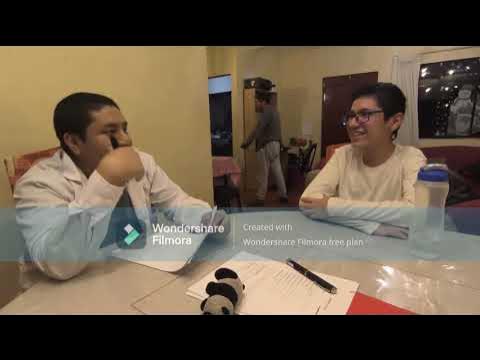Biologist Answers Biology Questions From Twitter | Tech Support | WIRED
Summary
TLDREn este video, el biólogo y autor Thor Hanson responde a una variedad de preguntas de Twitter sobre biología. Explora temas como si los virus están vivos, la evolución de las plantas, cómo los ojos azules son una mutación reciente, y el debate sobre cómo las especies evolucionan. Hanson también aborda cuestiones sobre la bioética, el cambio climático y sus efectos en la fauna, así como misterios sin resolver como el porqué bostezamos. Con un enfoque accesible y educativo, el video ofrece una visión fascinante del mundo natural y la ciencia biológica.
Takeaways
- 🧬 Los virus no cumplen con la definición tradicional de vida, ya que no tienen células y necesitan células vivas para reproducirse.
- 🌵 Las suculentas son difíciles de cuidar en interiores porque han evolucionado para sobrevivir en condiciones extremadamente secas.
- 🌱 Las semillas varían enormemente en tamaño, desde las diminutas semillas de las orquídeas hasta la gran semilla de doble coco.
- 🦖 El Archaeopteryx es un fósil crucial que muestra características tanto de reptiles como de aves, sugiriendo que las aves son dinosaurios vivos.
- 🐶 Los perros y los lobos pueden cruzarse, ya que los perros descienden de los lobos, pero los perros y los zorros no pueden, ya que son genéticamente más distantes.
- 🐟 La transición de los peces a la tierra no fue un proceso lineal; la evolución es un fenómeno complejo y multifacético.
- 🧠 La evolución humana ha estado marcada por el aumento del tamaño cerebral, que requiere un mayor consumo de calorías.
- 🍌 El CRISPR es una herramienta biotecnológica que podría ayudar a las bananas Cavendish a resistir la amenaza de hongos.
- 🌿 Las plantas generalmente crecen desde la parte superior, pero algunas, como los pastos, crecen desde la base para adaptarse a la herbivoría y el corte.
- 🌡️ El cambio climático impacta a la fauna de manera significativa, provocando que muchas especies migren, se adapten o enfrenten la extinción.
Q & A
¿Por qué los virus no se consideran organismos vivos?
-Los virus no se consideran vivos porque no tienen células y solo pueden reproducirse al cooptar las capacidades reproductivas de una célula viva, lo cual no cumple con la definición tradicional de vida en biología.
¿Por qué las suculentas son difíciles de mantener como plantas de interior?
-Las suculentas están adaptadas a condiciones de sequía extrema en la naturaleza, y es difícil replicar esas condiciones dentro de una casa, lo que las hace plantas delicadas para cuidar en interiores.
¿Qué es un ejemplo de la diferencia en tamaño de semillas en la naturaleza?
-Un ejemplo extremo es la diferencia entre las semillas de la orquídea Coralroot, que son del tamaño de partículas de polvo, y la semilla del coco doble, que puede llegar a pesar 40 libras.
¿La teoría de la evolución de Darwin también se aplica a las plantas?
-Sí, la teoría de Darwin de la evolución por selección natural también se aplica a las plantas.
¿Por qué los lobos y los perros pueden cruzarse, pero no los perros y los zorros?
-Los lobos y los perros pueden cruzarse porque son parientes cercanos y pertenecen al mismo género, mientras que los zorros pertenecen a un género diferente, lo que impide que se crucen.
¿Cómo fue posible que algunos peces evolucionaran para caminar en tierra?
-Aunque no sabemos con precisión cómo ocurrió, todavía existen criaturas como el pez pulmonado, que puede arrastrarse brevemente sobre la tierra. Este tipo de transición de los peces al caminar fue un proceso gradual y complejo.
¿Por qué la yawn (bostezo) sigue siendo un misterio para los científicos?
-A pesar de ser una acción común, los científicos aún no entienden completamente por qué las personas bostezan, lo que demuestra que incluso los fenómenos más cotidianos pueden ser un misterio.
¿Cómo afecta el cambio climático a la vida silvestre?
-El cambio climático está obligando a las especies a moverse, adaptarse o morir. Muchas están cambiando de hábitat, adaptando sus comportamientos o dietas, mientras que otras están desapareciendo por completo.
¿Por qué los ojos azules son el resultado de una mutación reciente?
-Los ojos azules son el resultado de una mutación en el ADN que ocurrió relativamente reciente en la historia humana. Aunque no se conoce la ventaja evolutiva específica de esta mutación, ha persistido en algunas poblaciones.
¿Cómo está afectando el cambio climático a la interacción entre chimpancés y gorilas?
-En Gabón, los científicos han observado recientemente a chimpancés atacando y matando gorilas, lo cual podría estar relacionado con la competencia por recursos alimenticios debido a los cambios climáticos.
Outlines

This section is available to paid users only. Please upgrade to access this part.
Upgrade NowMindmap

This section is available to paid users only. Please upgrade to access this part.
Upgrade NowKeywords

This section is available to paid users only. Please upgrade to access this part.
Upgrade NowHighlights

This section is available to paid users only. Please upgrade to access this part.
Upgrade NowTranscripts

This section is available to paid users only. Please upgrade to access this part.
Upgrade NowBrowse More Related Video
5.0 / 5 (0 votes)






